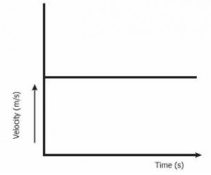Motion If car A is at 80 km/h and car B is at 60 km/h in the same direction, what is
the velocity of thecar A relative to the car B?
(1)
40 km/h
(2)
20 km/h
(3)
10 km/h
(4)
30 km/h
| A. | Option 1 |
| B. | Option 2 |
| C. | Option 3 |
| D. | Option 4 |
|
Option: 2 Solution : -. |
Motion The distance covered by the body between 30-40 seconds is

(1)
40m
(2)
50m
(3)
60m
(4)
20m
| A. | Option 1 |
| B. | Option 2 |
| C. | Option 3 |
| D. | Option 4 |
|
Option: 4 Solution : -. |
Motion The area enclosed by velocity-time graph and the time axis will be equal to
the magnitude of
(1) displacement
(2) speed
(3) acceleration
(4) distance
| A. | Option 1 |
| B. | Option 2 |
| C. | Option 3 |
| D. | Option 4 |
|
Option: 1 Solution : -. |
Motion A boy throws a ball up and catches it when the ball falls back. In which part
of the motion the ball is accelerating?
(1)
During downward motion
(2)
When the ball comes to rest
(3)
During upward motion
(4)
When the boy catches the ball
| A. | Option 1 |
| B. | Option 2 |
| C. | Option 3 |
| D. | Option 4 |
|
Option: 1 Solution : -. |
Motion The velocity-time graph of an object moving in a fixed direction is shown in the figure below.

What do you conclude about the object?
(1) Moves with a constant speed.
(2) Moves with varying speeds.
(3) Moves with a non zero acceleration.
(4) Is at rest.
| A. | Option 1 |
| B. | Option 2 |
| C. | Option 3 |
| D. | Option 4 |
|
Option: 1 Solution : -. |
Motion Distance-time graph of two objects A and B are shown below.

(1)
Which statement is true for the speed of object A and B ?
(2)
Speed of object A is greater than object B
Speed of object A is smaller than object B
(3)
Both have same speed
(4)
Speed of Object A is double the speed of object B.
| A. | Option 1 |
| B. | Option 2 |
| C. | Option 3 |
| D. | Option 4 |
|
Option: 2 Solution : -. |
Motion A body freely falling from rest has a velocity v after it falls through a height h. The distance it has to fall further for its velocity to become double is -
(1) 3 h
(2) 6 h
(3) 8 h
(4) 10 h
| A. | Option 1 |
| B. | Option 2 |
| C. | Option 3 |
| D. | Option 4 |
|
Option: 1 Solution : -. |
Motion A thin uniform metal rod of mass ' m' and length ‘ l’ standing vertically
is now allowed to fall due to its own weight.
The velocity with which its mid-point will strike ground will be :

| A. | Option 1 |
| B. | Option 2 |
| C. | Option 3 |
| D. | Option 4 |
|
Option: 4 Solution : -. |
Motion

Which motion does the graph of distance and time shows for accelerated motion?
(1) Non-uniformly accelerated
(2) Constant accelerated
(3) Uniformly accelerated
(4) Uniformly retarded motion
| A. | Option 1 |
| B. | Option 2 |
| C. | Option 3 |
| D. | Option 4 |
|
Option: 3 Solution : -. |